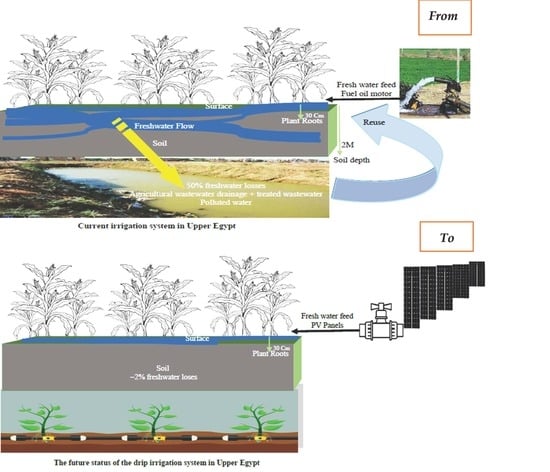Sustainable Development Goals for the Circular Economy and the Water-Food Nexus: Full Implementation of New Drip Irrigation Technologies in Upper Egypt
Abstract
1. Introduction
1.1. Egyptian Water Policy & Strategy
1.2. Water Resources and Usages
1.3. Targeted Water Resources
- The “Jonglei Canal (JC) project” in South Sudan, which could provide ~ 4 BM3/year in its first stage and around 3 BM3/year in its second stage, to be divided evenly between South Sudan and Egypt.
- The “Bahr al-Ghazal (BG) project”, which provides about 7 BM3/year, to be divided evenly between South Sudan and Egypt.
- The “Mushar Swamps (MS) project”, which provides about 4 BM3/year of water.
- Seawater desalination is one of the future prospecting for increasing water resources, especially since its cost is decreasing by using modern technologies. It is about 0.41 BM3/year in 2021.
- Amending the existing cropping structure in line with the State’s water, productivity, export policy, and reducing the quantities of irrigation water for the cropped area, as the State’s plan aims to provide about 1.5 BM3/year by substituting beet cultivation for sugar cane and decreasing the cultivated rice area from 1.3 million acres to 0.95 million acres.
- Reducing water losses; the Water Resources and Irrigation Ministry estimated water losses at approximately 35% of the total water discharge from the High Dam, or approximately 19.4 BM3, and it is likely that it is lost by evaporation and leakage, and the loss in channels of irrigation represents approximately 2.3 BM3/year.
- Conservation of water resources by getting rid of weeds and aquatic plants resulting from their growth and saving about 0.75 BM3/year.
1.4. Per Capita Share of Water in Egypt for the Last 60 Years
- Using public pumping stations, which pump water from sewers into irrigation canals. The amount used in this way is estimated at ~4.5 BM3/y in the Delta and 0.9 BM3/y in Fayoum and Upper Egypt.
- In an informal way, by the farmers themselves when they suffer from canal water shortage. This is estimated at 2.8 BM3/y in the Delta alone.
- Indirectly from drains in Upper Egypt, which drain into the Nile River, and this quantity is ~4 BM3/y.
2. Methods
2.1. Current Diagnosis
2.1.1. The New Delta Project
2.1.2. New Upper Egypt Project
3. Results and Discussion
3.1. Drip Irrigations Technology
3.2. Diagnosing the Future State
3.3. Capex and SDGs
- (1)
- Horizontal expansion, which aims to increase the agricultural area, compensating for the areas that were lost because of encroachments on it; achieving integrated development; increasing employment opportunities; and creating urban communities and areas that attract residents to reduce population density in some areas. The most important horizontal expansion projects are the New Delta project, which aims to achieve comprehensive development of an area 2.2 million acres, depending on modern technology in agriculture, drip irrigation, the use of artificial intelligence mechanisms; and it aims to grow strategic crops to reduce the food gap, including (wheat, maize, legumes, and oil crops), and expand related projects such as agricultural manufacturing, animal and poultry production stations, and farming integrated fish filling and export stations, silos for storage and others.
- (2)
- The North and Central Sinai development project of about 500,000 acres and the Toshka, South Valley and West Minya areas development project, in contrast to the new Egyptian rural development project, is for an area of 1.5 million acres. All of these projects aim to increase the agricultural area by about 4 million acres, which is equivalent to more than 65% of the old land area, as the implementation of such projects requires huge sums of money to provide water from multiple sources, whether from agricultural wastewater treatment, seawater desalination, or of groundwater, which the state seeks to implement, despite the high costs, in order to achieve the targeted food security.
- (3)
- In the field of vertical expansion, the Egyptian State, through experts, researchers and agricultural producers, has been able to improve farming methods, rely on mechanisms that reduce water needs, and devise early-maturing varieties that are able to withstand climate change, which has greatly contributed to raising the average productivity and maximizing the efficiency of the use of land and water resources.
- (4)
- In light of the water poverty that the Egyptian state suffers from, an initiative has been implemented to encourage farmers to switch to modern irrigation systems, within the framework of the State’s direction, in order to maximize and raise the efficiency of water use, whether in new lands or in old lands. An initiative was launched to encourage transformation processes with easy financing from banks, to be paid over 10 years without interest, and with supervision and technical support from the Ministries of Agriculture, Land Reclamation, Water Resources and Irrigation, and this aims to convert an area of 3.7 million acres from flood irrigation systems to drip irrigation systems, in addition to the national project for lining canals at a cost of more than 20 billion Egyptian pounds [55].
4. Conclusions
- (1)
- Environmentally, the project will contribute to reducing agricultural waste-water usage, reducing pollution, and greenhouse gas emissions.
- (2)
- For the farmer, it will reduce irrigation time, labor costs and increase the income of rural families.
- (3)
- Increase productivity, new land areas, improve water transfer efficiency, improve field irrigation efficiency, and achieve equitable distribution of irrigation water.
- (4)
- Drip irrigation systems are important to support farms to meet the challenges facing the agricultural sector, which effect agricultural productivity, adverse climatic changes and water scarcity.
- (5)
- The drip irrigation system maintains the sustainability of water and agriculture by using the optimum available water resources and increasing the acres’ productivity in order to achieve a circular economy.
- (6)
- Holding awareness seminars and workshops in Upper Egypt governorates and agricultural directorates to educate farmers about the importance of switching to drip irrigation systems.
Author Contributions
Funding
Conflicts of Interest
References
- Turhan, Y. The hydro-political dilemma in Africa water geopolitics: The case of the Nile river basin. Afr. Secur. Rev. 2021, 30, 66–85. [Google Scholar] [CrossRef]
- Yalew, S.; Kwakkel, J.; Doorn, N. Distributive Justice and Sustainability Goals in Transboundary Rivers: Case of the Nile Basin. Front. Environ. Sci. 2021, 8, 590954. [Google Scholar] [CrossRef]
- Pemunta, N.V.; Ngo, N.V.; Fani Djomo, C.R.; Mutola, S.; Seember, J.A.; Mbong, G.A.; Forkim, E.A. The Grand Ethiopian Renaissance Dam, Egyptian National Security, and human and food security in the Nile River Basin. Cogent Soc. Sci. 2021, 7, 1875598. [Google Scholar] [CrossRef]
- Abtew, W.; Dessu, S.B. Dialogue and Diplomacy Through the Construction of the Grand Ethiopian Renaissance Dam. In The Grand Ethiopian Renaissance Dam on the Blue Nile; Springer: Cham, Switzerland, 2019; pp. 131–146. [Google Scholar]
- Elkholy, M. Assessment of water resources in Egypt: Current status and future plan. In Groundwater in Egypt’s Desert; Springer: Cham, Switzerland, 2021; pp. 395–423. [Google Scholar]
- Salman, S.M. The Grand Ethiopian Renaissance Dam: The road to the declaration of principles and the Khartoum document. Water Int. 2016, 41, 512–527. [Google Scholar] [CrossRef]
- Ghanem, S.K. The relationship between population and the environment and its impact on sustainable development in Egypt using a multi-equation model. Environ. Dev. Sustain. 2018, 20, 305–342. [Google Scholar] [CrossRef]
- Abutaleb, K.A.A.; Mohammed, A.H.E.-S.; Ahmed, M.H.M. Climate change impacts, vulnerabilities and adaption measures for Egypt’s Nile Delta. Earth Syst. Environ. 2018, 2, 183–192. [Google Scholar] [CrossRef]
- AbuZeid, K.M. Existing and recommended water policies in Egypt. In Water Policies in MENA Countries; Springer: Cham, Switzerland, 2020; pp. 47–62. [Google Scholar]
- Eldardiry, H.; Hossain, F. The value of long-term streamflow forecasts in adaptive reservoir operation: The case of the High Aswan Dam in the transboundary Nile River basin. J. Hydrometeorol. 2021, 22, 1099–1115. [Google Scholar] [CrossRef]
- Jeuland, M.; Wu, X.; Whittington, D. Infrastructure development and the economics of cooperation in the Eastern Nile. Water Int. 2017, 42, 121–141. [Google Scholar] [CrossRef]
- Abdelaal, H. Food Security Concerns and Sustainable Agricultural Production in Egypt. J. Agric. Econ. Soc. Sci. 2021, 12, 529–534. [Google Scholar] [CrossRef]
- Gohar, A.A.; Ward, F.A. Gains from expanded irrigation water trading in Egypt: An integrated basin approach. Ecol. Econ. 2010, 69, 2535–2548. [Google Scholar] [CrossRef]
- Dwivedi, Y.K.; Hughes, L.; Kar, A.K.; Baabdullah, A.M.; Grover, P.; Abbas, R.; Andreini, D.; Abumoghli, I.; Barlette, Y.; Bunker, D. Climate change and COP26: Are digital technologies and information management part of the problem or the solution? An editorial reflection and call to action. Int. J. Inf. Manag. 2022, 63, 102456. [Google Scholar] [CrossRef]
- Srour, E.; Hussien, R.; Moustafa, W. Geochemical modeling and isotopic approach for delineating water resources evolution in El Fayoum depression, Egypt. Environ. Earth Sci. 2022, 81, 105. [Google Scholar] [CrossRef]
- Abdelhaleem, F.S.; Basiouny, M.; Ashour, E.; Mahmoud, A. Application of remote sensing and geographic information systems in irrigation water management under water scarcity conditions in Fayoum, Egypt. J. Environ. Manag. 2021, 299, 113683. [Google Scholar] [CrossRef] [PubMed]
- Abd-Elhamid, H.F.; Ahmed, A.; Zeleňáková, M.; Vranayová, Z.; Fathy, I. Reservoir management by reducing evaporation using floating photovoltaic system: A case study of Lake Nasser, Egypt. Water 2021, 13, 769. [Google Scholar] [CrossRef]
- ElFetyany, M.; Farag, H.; Abd El Ghany, S.H. Assessment of national water footprint versus water availability-Case study for Egypt. Alex. Eng. J. 2021, 60, 3577–3585. [Google Scholar] [CrossRef]
- Hunter, D.B.; Salzman, J.E.; Zaelke, D. Glasgow Climate Summit: Cop26; UCLA School of Law, Public Law Research Paper; UCLA: Los Angeles, CA, USA, 2021. [Google Scholar]
- Tantawy, M.; El-Roudi, A.; Abdalla, E.M.; Abdelzaher, M. Fire resistance of sewage sludge ash blended cement pastes. J. Eng. 2013, 2013, 361582. [Google Scholar] [CrossRef]
- Mostafa, S.M.; Wahed, O.; El-Nashar, W.Y.; El-Marsafawy, S.M.; Zeleňáková, M.; Abd-Elhamid, H.F. Potential Climate Change Impacts on Water Resources in Egypt. Water 2021, 13, 1715, Erratum in Water 2021, 13, 1919. [Google Scholar] [CrossRef]
- Van Griensven, A.; Ndomba, P.; Yalew, S.; Kilonzo, F. Critical review of SWAT applications in the upper Nile basin countries. Hydrol. Earth Syst. Sci. 2012, 16, 3371–3381. [Google Scholar] [CrossRef]
- Abbas, R.; Shehata, N.; Mohamed, E.A.; Salah, H.; Abdelzaher, M. Environmental safe disposal of cement kiln dust for the production of geopolymers. Egypt. J. Chem. 2021, 64, 7429–7437. [Google Scholar]
- Sadek, N. The effect of upper nile projects implementation on water management strategy. In Proceedings of the Twenty Six Arab Engineering Conference on “Water Resources in Arab Countries”, Jeddah, Saudi Arabia, 15–17 January 2012. [Google Scholar]
- Raveendranathan, D. Developments Lead to Pollution and Depletion of Natural Resources; Notion Press: Chennai, India, 2018. [Google Scholar]
- Abdrabo, M.A.; Hassaan, M.A. Assessment of Policy-Research Interaction on Climate Change Adaptation Action: Inundation by Sea Level Rise in the Nile Delta. J. Geosci. Environ. Prot. 2020, 8, 314. [Google Scholar] [CrossRef]
- Saleh, H.; AL-KAHLIDI, M.; Abulridha, H.A.; Banoon, S.R.; Abdelzaher, M.A. Current situation and future prospects for plastic waste in maysan governorate: Effects and treatment during the COVID-19 pandemic. Egypt. J. Chem. 2021, 64, 4449–4460. [Google Scholar] [CrossRef]
- Stancu-Minasian, I. A Ninth Bibliography of Fractional Programming; Taylor & Francis: Abingdon, UK, 2019. [Google Scholar]
- El Sayed Frihy, O.; Deabes, E.A.; Shereet, S.M.; Abdalla, F.A. Alexandria-Nile Delta coast, Egypt: Update and future projection of relative sea-level rise. Environ. Earth Sci. 2010, 61, 253–273. [Google Scholar] [CrossRef]
- Shouny, A.E.; Yakoub, N.; Hosny, M. Evaluating the performance of using PPK-GPS technique in producing topographic contour map. Mar. Geod. 2017, 40, 224–238. [Google Scholar] [CrossRef]
- Mohamed, H.F. Spatial analysis of sea level rise in Egypt’s northern coast and its influence on the geodetic vertical datum. Int. J. Geomat. Geosci. 2015, 6, 45. [Google Scholar]
- Ismail, M.; Yehia, H.; Morsy, I. Natural Resources Assessment and Sea Level Rise Impact Using GIS and RS for North Alexandria and Kafr El Dawar District, Egypt. Alex. Sci. Exch. J. 2016, 37, 831–850. [Google Scholar]
- Nikiel, C.A.; Eltahir, E.A. Past and future trends of Egypt’s water consumption and its sources. Nat. Commun. 2021, 12, 4508. [Google Scholar] [CrossRef]
- Scardigno, A. MADFORWATER. WP5 Strategies and Economic Instruments for Basin-Scale Water Resources Management. Treated Wastewater Reuse on Citrus in Morocco. Assessing the Economic Feasibility of Irrigation and Nutrient Management Strategies; Università di Bologna: Bologna, Italy, 2020. [Google Scholar]
- Khairy, W.M.; Kamal, R. Economic Valuation of Treated Wastewater use in Sustainable Agriculture-New El-Mahsama Wastewater Treatment Plant in Sinai, Egypt. Lond. J. Res. Sci. Nat. Form. 2021, 21, 45–60. [Google Scholar]
- Abdelzaher, M. Experiential investigation on the effect of heavy fuel oil substitution by high sulfur petcoke on the physico-mechanical features and microstructure of white cement composites. Eng. Res. Express 2021, 3, 015028. [Google Scholar] [CrossRef]
- Balboul, B.A.; Abdelzaher, M.; Hamouda, A.S.; Zaki, A. Nano titania combined with micro silica reinforced limestone cement: Physico-mechanical investigation. Egypt. J. Chem. 2019, 62, 1105–1115. [Google Scholar]
- Gabr, M.E.; Soussa, H.; Fattouh, E. Groundwater quality evaluation for drinking and irrigation uses in Dayrout city Upper Egypt. Ain Shams Eng. J. 2021, 12, 327–340. [Google Scholar] [CrossRef]
- Elbeih, S.F.; Madani, A.A.; Hagage, M. Groundwater deterioration in Akhmim District, Upper Egypt: A Remote Sensing and GIS investigation approach. Egypt. J. Remote Sens. Space Sci. 2021, 24, 919–932. [Google Scholar] [CrossRef]
- Barkunan, S.; Bhanumathi, V.; Sethuram, J. Smart sensor for automatic drip irrigation system for paddy cultivation. Comput. Electr. Eng. 2019, 73, 180–193. [Google Scholar] [CrossRef]
- Elkhouly, H.I.; Abdelzaher, M.; El-Kattan, I.M. Experimental and modeling investigation of physicomechanical properties and firing resistivity of cement pastes incorporation of micro-date seed waste. Iran. J. Sci. Technol. Trans. Civ. Eng. 2021, 46, 2809–2821. [Google Scholar] [CrossRef]
- PK, A.N.; Ding, X.W.; Page, T. A New Model for Automatic Agricultural Field Monitoring. i-Manag. J. Embed. Syst. 2019, 8, 10. [Google Scholar]
- Abdelzaher, M.A.; Shehata, N. Hydration and synergistic features of nanosilica-blended high alkaline white cement pastes composites. Appl. Nanosci. 2022, 12, 1731–1746. [Google Scholar] [CrossRef]
- Nallani, S.; Hency, V.B. Low power cost effective automatic irrigation system. Indian J. Sci. Technol. 2015, 8, IPL0325. [Google Scholar] [CrossRef]
- Kim, Y.; Evans, R. Software design for wireless sensor-based site-specific irrigation. Comput. Electron. Agric. 2009, 66, 159–165. [Google Scholar] [CrossRef]
- Abdelzaher, M.A.; Hamouda, A.S.; El-Kattan, I.M.; Baher, A. Laboratory study for accelerating the CKD mineral carbonation. Egypt. J. Chem. 2022, 65, 1–2. [Google Scholar] [CrossRef]
- Moysiadis, V.; Sarigiannidis, P.; Vitsas, V.; Khelifi, A. Smart farming in Europe. Comput. Sci. Rev. 2021, 39, 100345. [Google Scholar] [CrossRef]
- Wolfert, S.; Ge, L.; Verdouw, C.; Bogaardt, M.-J. Big data in smart farming—A review. Agric. Syst. 2017, 153, 69–80. [Google Scholar] [CrossRef]
- Virk, A.L.; Noor, M.A.; Fiaz, S.; Hussain, S.; Hussain, H.A.; Rehman, M.; Ahsan, M.; Ma, W. Smart farming: An overview. In Smart Village Technology; Springer: Cham, Switzerland, 2020; pp. 191–201. [Google Scholar]
- Rajasekaran, T.; Anandamurugan, S. Challenges and applications of wireless sensor networks in smart farming—A survey. In Advances in Big Data and Cloud Computing; Springer: Singapore, 2019; pp. 353–361. [Google Scholar]
- Boursianis, A.D.; Papadopoulou, M.S.; Diamantoulakis, P.; Liopa-Tsakalidi, A.; Barouchas, P.; Salahas, G.; Karagiannidis, G.; Wan, S.; Goudos, S.K. Internet of things (IoT) and agricultural unmanned aerial vehicles (UAVs) in smart farming: A comprehensive review. Internet Things 2022, 18, 100187. [Google Scholar] [CrossRef]
- Montesano, F.F.; Van Iersel, M.W.; Boari, F.; Cantore, V.; D’Amato, G.; Parente, A. Sensor-based irrigation management of soilless basil using a new smart irrigation system: Effects of set-point on plant physiological responses and crop performance. Agric. Water Manag. 2018, 203, 20–29. [Google Scholar] [CrossRef]
- Abdelzaher, M.A. Performance and hydration characteristic of dark white evolution (DWE) cement composites blended with clay brick powder. Egypt. J. Chem. 2022, 65, 1–6. [Google Scholar] [CrossRef]
- Owaid, K.A.; Hamdoon, A.A.; Maty, R.R.; Saleh, M.Y.; Abdelzaher, M. Waste Polymer and Lubricating Oil Used as Asphalt Rheological Modifiers. Materials 2022, 15, 3744. [Google Scholar] [CrossRef] [PubMed]
- Zinkernagel, J.; Maestre-Valero, J.F.; Seresti, S.Y.; Intrigliolo, D.S. New technologies and practical approaches to improve irrigation management of open field vegetable crops. Agric. Water Manag. 2020, 242, 106404. [Google Scholar] [CrossRef]
- Morillo, J.G.; Díaz, J.A.R.; Camacho, E.; Montesinos, P. Linking water footprint accounting with irrigation management in high value crops. J. Clean. Prod. 2015, 87, 594–602. [Google Scholar] [CrossRef]
- Reca, J.; Trillo, C.; Sánchez, J.; Martínez, J.; Valera, D. Optimization model for on-farm irrigation management of Mediterranean greenhouse crops using desalinated and saline water from different sources. Agric. Syst. 2018, 166, 173–183. [Google Scholar] [CrossRef]
- Sangwan, K.S.; Bhakar, V. Life cycle analysis of HDPE pipe manufacturing—A case study from an Indian industry. Procedia CIRP 2017, 61, 738–743. [Google Scholar] [CrossRef]
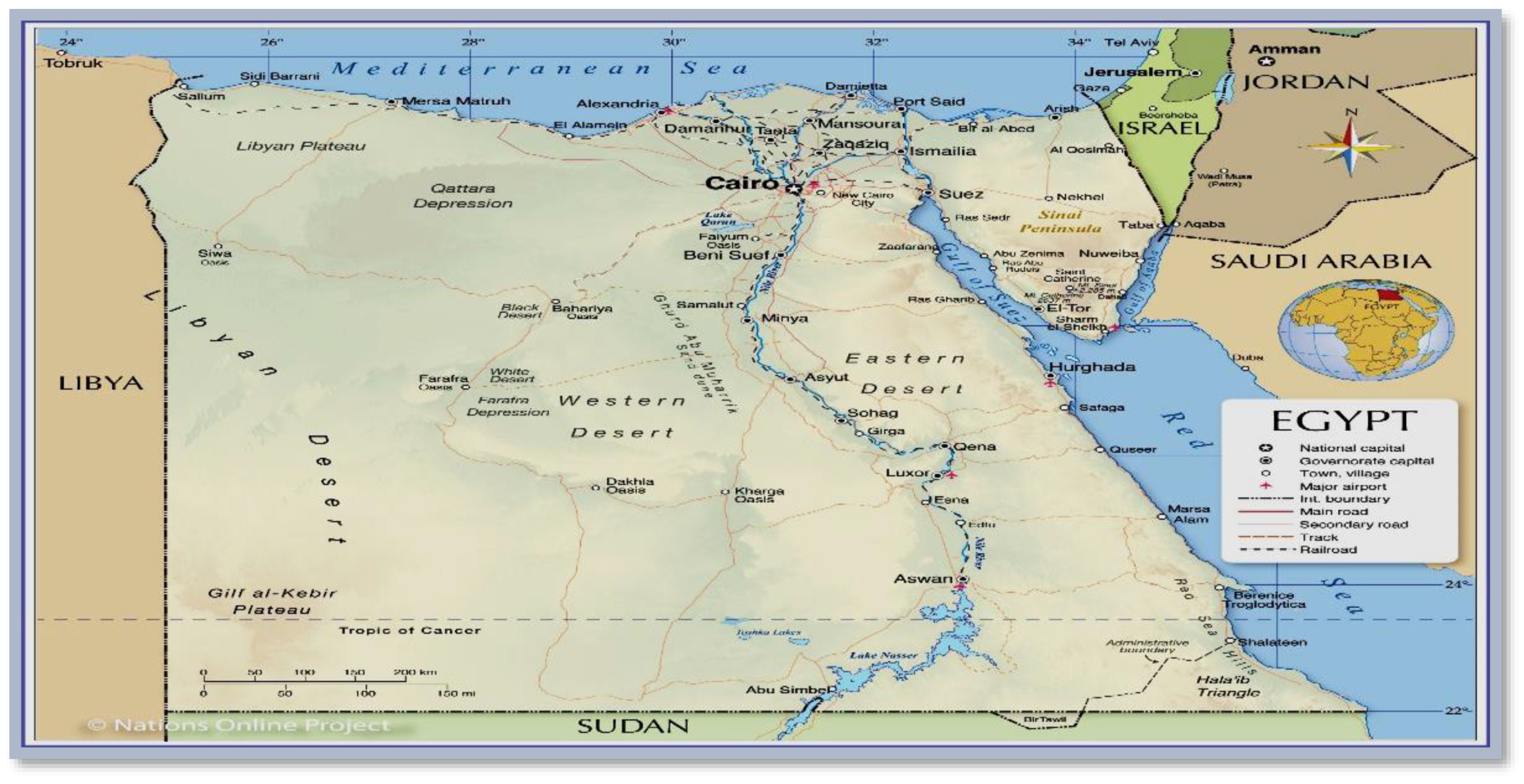
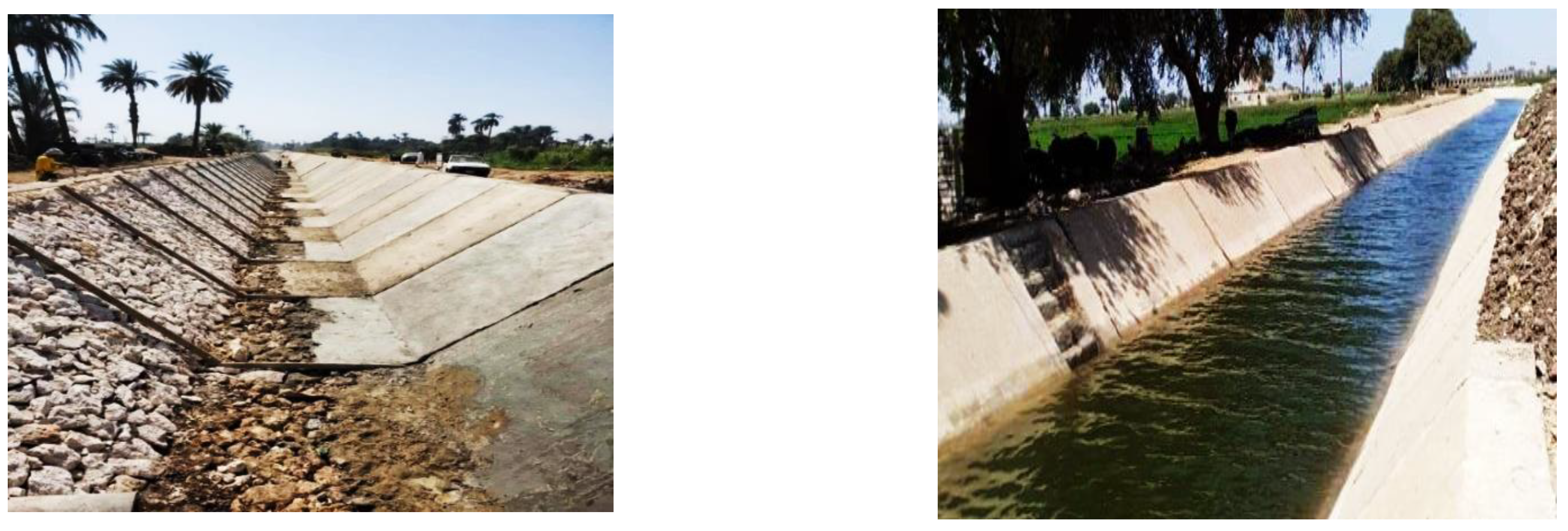
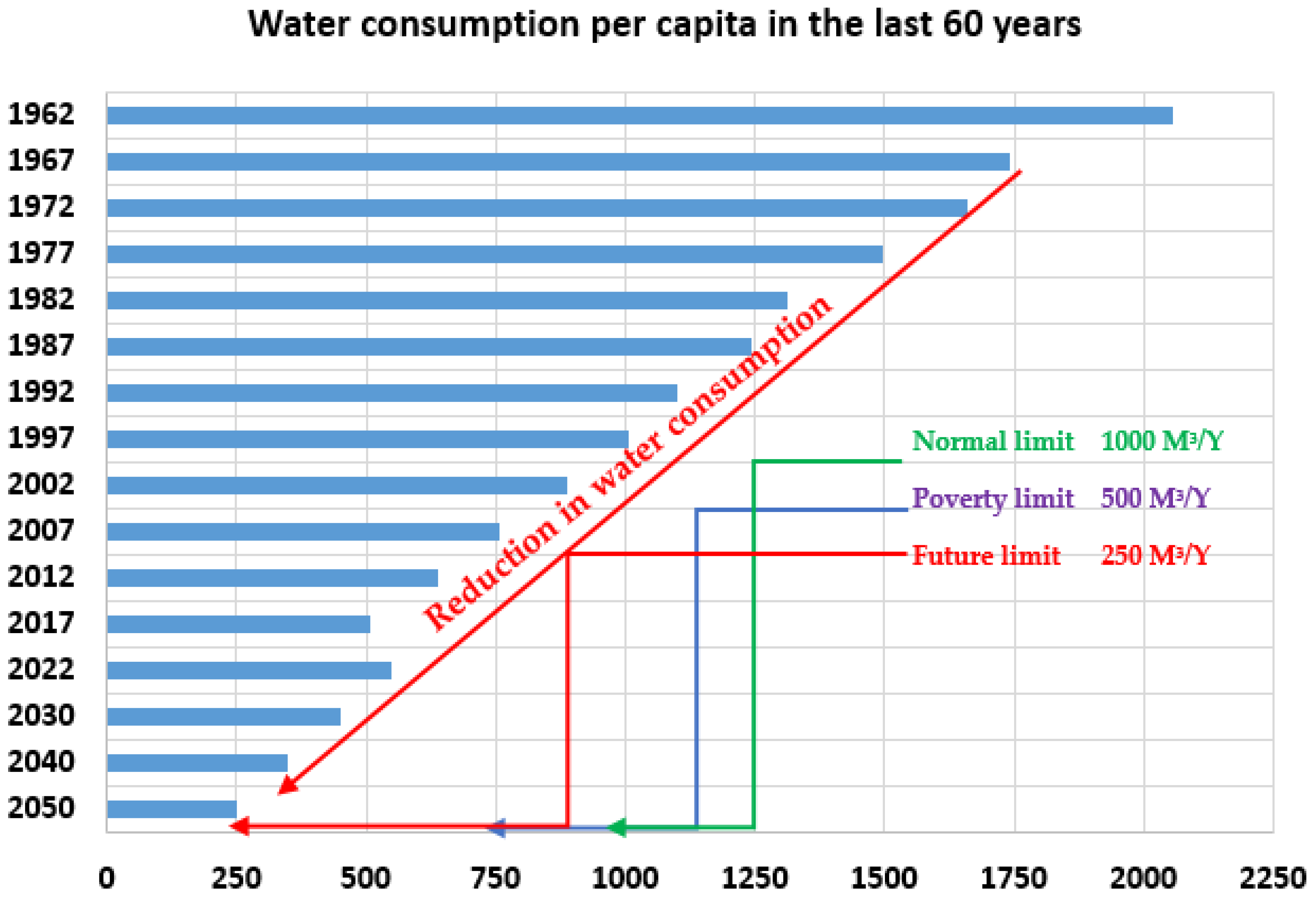
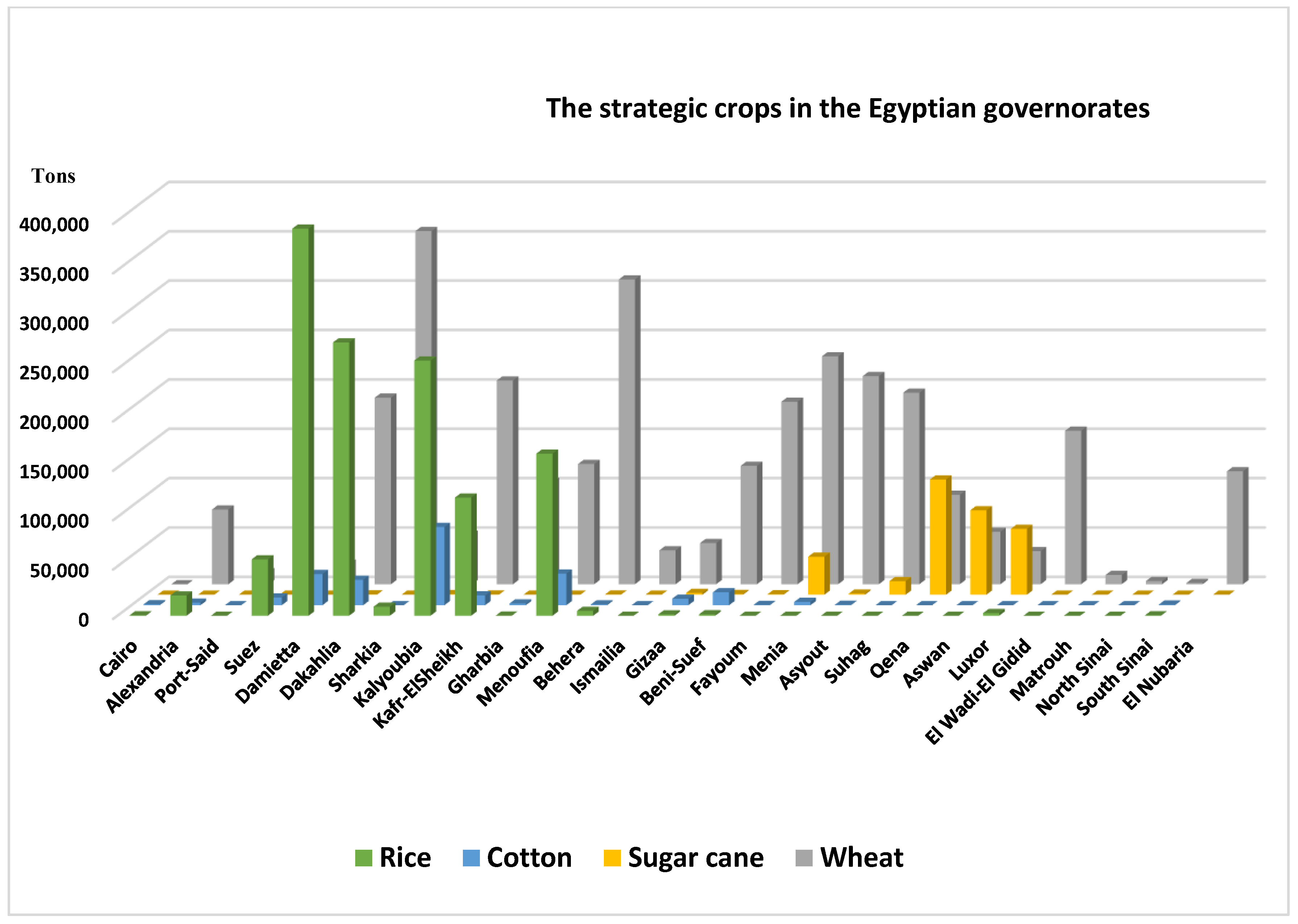
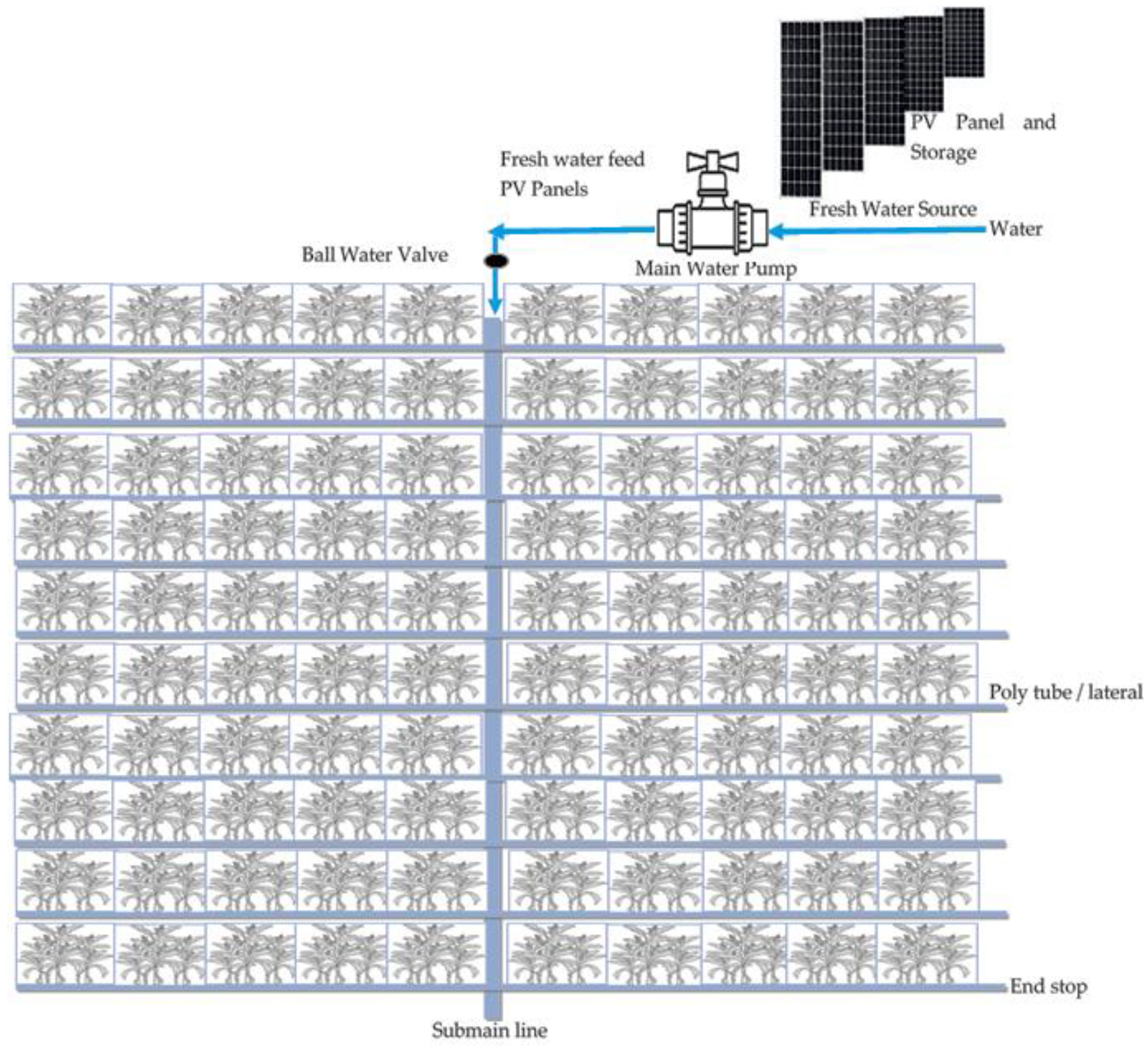
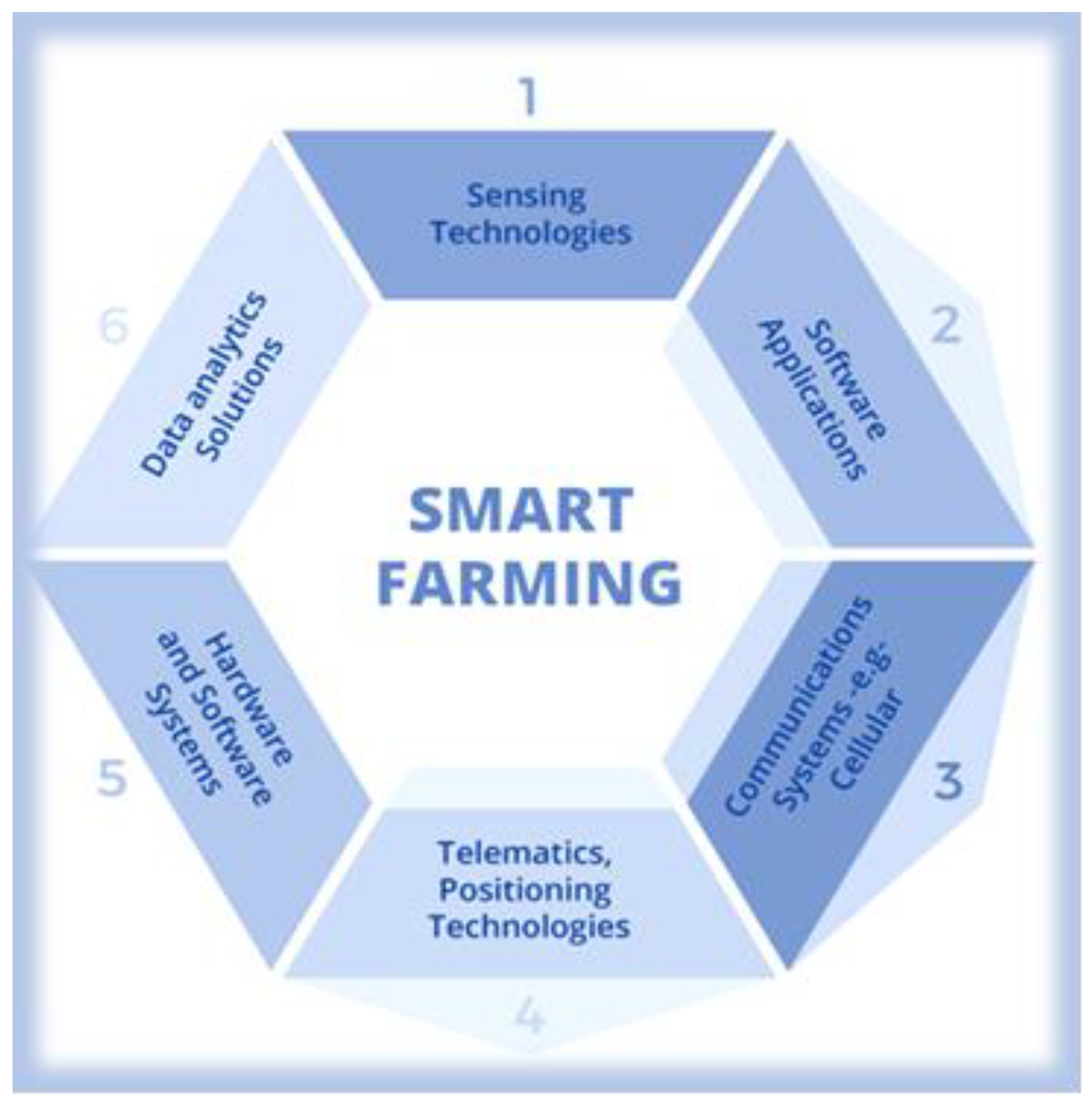
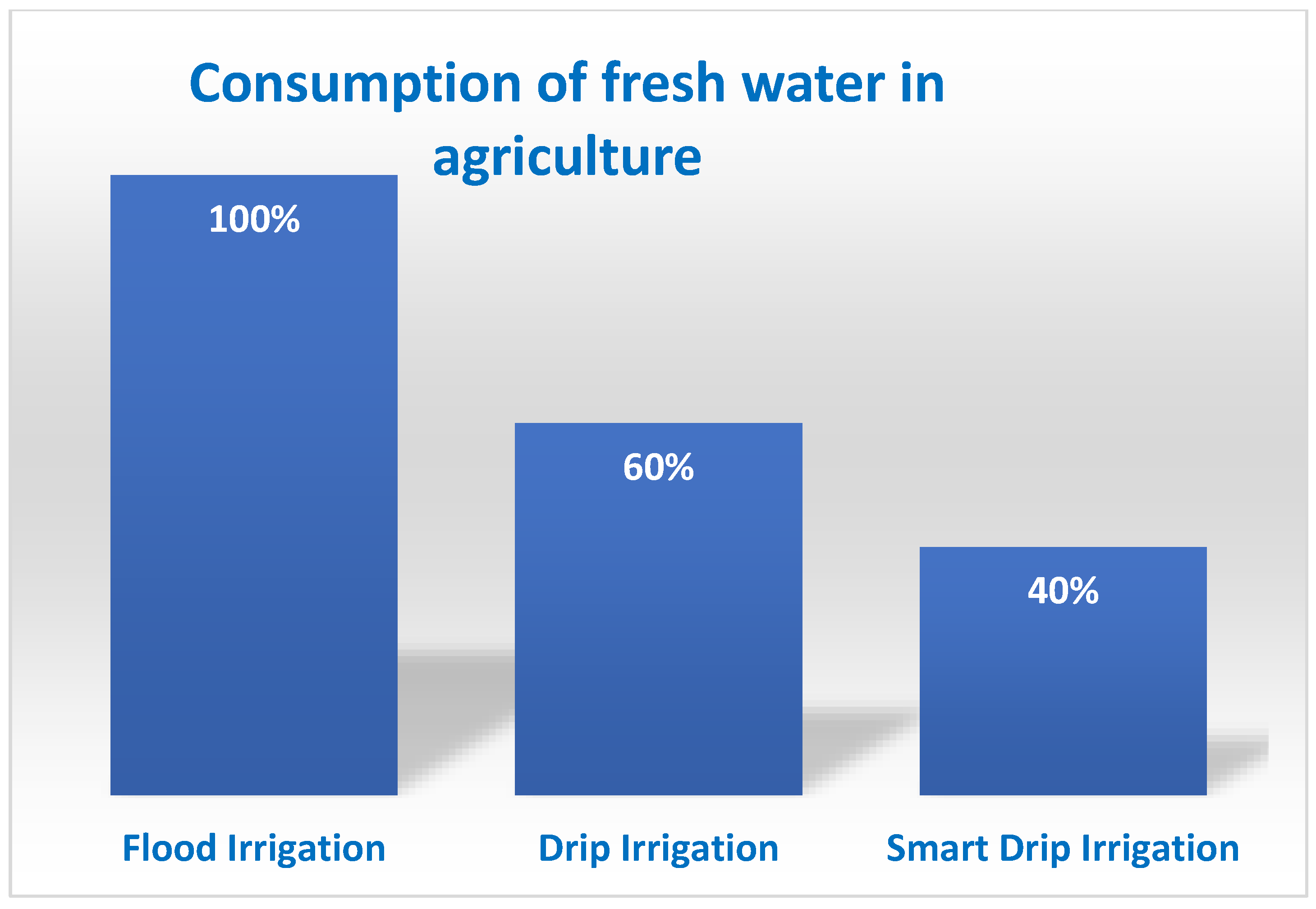

| Water Sources | Description | Quantity of BM3/Year | Percentage % |
|---|---|---|---|
| The Nile River | It is the main water source in Egypt, | 55.5 | 68.19% |
| Underground water | The amount can be enhanced to reach 7.5 BM3/year without endangering the groundwater reserves. | 6.11 | 7.50% |
| Rainfall | It is not the major water source in Egypt due to the small amount that falls in winter. | 1.37 | 1.68% |
| Desalination | Treated seawater (salinity ≥ 45,000 ppm). | 0.41 | 0.51% |
| Reuse of agricultural wastewater | Agricultural drainage water is a significant water resource. | 7.88 | 9.68% |
| Treated wastewater | It is used in irrigation, only if it meets the recognizably international health conditions. | 10.12 | 12.44% |
| Total water resources | 81.39 | 100.00% | |
| Water Usages | Description | Quantity of BM3/Year | Percent % |
|---|---|---|---|
| Agriculture | To cultivate 10.38 million acres, with the possibility of increasing the agricultural area to 12 million acres in 2030. The statistics indicated that the governorates of Lower Egypt ranked first, with an area of 6.3 million acres (60.6%), followed by the governorates of Upper Egypt, with an area of 3.2 million acres (30.6%). The urban governorates came in third place with an area of 0.8 million acres (8.1%), then the border governorates (New Valley) with an area of 0.08 million acres (0.7%) of the total area of control in 2021. | 61.63 | 75.74% |
| Municipal | It consists of sewage water (gray and black). | 11.86 | 14.56% |
| Industrial | Industrial wastewater. | 5.40 | 6.63% |
| Evaporation | Loss in water at the Nile River from its source to its estuary, excluding evaporation resulting from Lake Nasser (abut 10 BM3/year). | 2.50 | 3.07% |
| Total water resources | 81.39 | 100.00% | |
| Governorate | Rice Tons | Sugar Cane Tons | Cotton Tons | Wheat Tons | Population Million |
|---|---|---|---|---|---|
| Cairo (a) | -- | 11 | -- | -- | 10.110 |
| Alexandria (a) | 380 | 3 | 966 | 75,635 | 5.475 |
| Port-Said (b) | 20,434 | -- | 2619 | 12,106 | 0.784 |
| Suez (b) | -- | -- | -- | 5401 | 0.780 |
| Damietta (b) | 57,008 | 3 | 7840 | 20,835 | 1.595 |
| Dakahlia (a) | 391,981 | 315 | 31,542 | 188,913 | 6.947 |
| Sharkia (b) | 276,726 | -- | 25,722 | 357,573 | 7.766 |
| Kalyoubia (a) | 9159 | 549 | 34 | 50,217 | 6.035 |
| Kafr-ElSheikh (b) | 258,338 | 115 | 79,307 | 206,242 | 3.646 |
| Gharbia (a) | 119,619 | -- | 9943 | 103,499 | 5.353 |
| Menoufia (a) | 25 | -- | 1746 | 121,763 | 4.652 |
| Behera (a) | 164,083 | 124 | 32,016 | 308,580 | 6.747 |
| Ismailia (b) | 4827 | -- | 797 | 34,333 | 1.426 |
| Giza (a) | - | 1769 | -- | 41,714 | 9.342 |
| Beni-Suef (b) | 1357 | 699 | 6597 | 119,910 | 3.510 |
| Fayoum (b) | 1381 | 450 | 13,092 | 184,715 | 3.994 |
| Menia (a) | -- | 38,432 | 306 | 230,780 | 6.157 |
| Asyout (b) | -- | 1175 | 3370 | 210,756 | 4.923 |
| Suhag (a) | -- | 13,710 | 430 | 193,939 | 5.572 |
| Qena (a) | -- | 116,616 | -- | 90,621 | 5.535 |
| Aswan (c) | -- | 85,491 | -- | 53,043 | 1.629 |
| Luxor (c) | -- | 66,684 | -- | 33,540 | 1.371 |
| El Wadi-El Gidid (b) | 2625 | -- | 12 | 155,408 | 0.261 |
| Matrouh (c) | -- | -- | -- | 9367 | 0.523 |
| North Sinai (c) | -- | -- | -- | 3200 | 0.450 |
| South Sinai (c) | -- | -- | -- | 1270 | 0.112 |
| El Nubaria (b) | 315 | 90 | 611 | 114,355 | 0.394 |
Publisher’s Note: MDPI stays neutral with regard to jurisdictional claims in published maps and institutional affiliations. |
© 2022 by the authors. Licensee MDPI, Basel, Switzerland. This article is an open access article distributed under the terms and conditions of the Creative Commons Attribution (CC BY) license (https://creativecommons.org/licenses/by/4.0/).
Share and Cite
Abdelzaher, M.A.; Awad, M.M. Sustainable Development Goals for the Circular Economy and the Water-Food Nexus: Full Implementation of New Drip Irrigation Technologies in Upper Egypt. Sustainability 2022, 14, 13883. https://doi.org/10.3390/su142113883
Abdelzaher MA, Awad MM. Sustainable Development Goals for the Circular Economy and the Water-Food Nexus: Full Implementation of New Drip Irrigation Technologies in Upper Egypt. Sustainability. 2022; 14(21):13883. https://doi.org/10.3390/su142113883
Chicago/Turabian StyleAbdelzaher, M. A., and Mohamed M. Awad. 2022. "Sustainable Development Goals for the Circular Economy and the Water-Food Nexus: Full Implementation of New Drip Irrigation Technologies in Upper Egypt" Sustainability 14, no. 21: 13883. https://doi.org/10.3390/su142113883
APA StyleAbdelzaher, M. A., & Awad, M. M. (2022). Sustainable Development Goals for the Circular Economy and the Water-Food Nexus: Full Implementation of New Drip Irrigation Technologies in Upper Egypt. Sustainability, 14(21), 13883. https://doi.org/10.3390/su142113883






